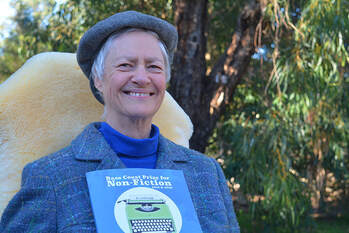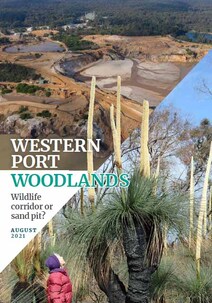 Writing long non-fiction is a bit like conducting an orchestra,
Writing long non-fiction is a bit like conducting an orchestra, Phillip Island author Christine Grayden said during her launch
of the Bass Coast Prize for Non-Fiction anthology.
I can’t be with you in person today so I’ve sent my voice along instead.
My son Simon and I are recording this on the country of the Yallock Bulluck clan of the Bunurong and Boonwurrung people. We pay our respects to their elders past, present, and emerging and thank them for all that they do. We also pay our respects to all Aboriginal and Torres Strait Islander people who may be with you today, or maybe listening to this in another forum.
 The Bass Coast Prize for Non-Fiction anthology is on sale for $25 at ArtSpace Wonthaggi or email [email protected]
The Bass Coast Prize for Non-Fiction anthology is on sale for $25 at ArtSpace Wonthaggi or email [email protected] The only ones I can remember are the two small volumes of “celebrating our sporting past” produced by the Bass Coast Shire about the mid-2000s as a means of familiarising the locals with the various parts and histories of their shire. The local historical societies across Bass Coast Shire were asked to provide some suitable historical images of sport and leisure activities from their collections. The images were shared around the Shire and the public were invited to select an image, research the team, sport or leisure activity pictured, and submit a written piece about the image.
The pieces selected were published in the two volumes along with the images that inspired them. These little books, which were freely and widely distributed, are full of information about lots of places across the Shire and are still available in our libraries. I recall the launch was held on neutral territory at the Bass Pub where about 60 people gathered from many parts of the Shire. All around me was the babble of people introducing themselves and their corners of the Shire. As a bonding exercise it was a stroke of genius, and an excellent example of the transformative power of non-fiction combined with image.
Some of you may know of other local non-fiction anthologies. But they would certainly be outnumbered manyfold by the number of locally published fiction anthologies. And almost certainly the non-fiction in any other anthology would be considerably shorter than the length required for the Bass Coast Prize for Non-Fiction.
The Bass Coast Prize for Non-Fiction has stimulated some exceptional work for the first 2 years of its existence. The four judges involved would have had a very difficult job.
Memoir-based writing predominates in this anthology; but the fact that the pieces are of the memoir genre is really their only similarity. The wide range of styles, topics and experiences covered by the memoir writers, despite all deriving from our geographical area in some way, are highly diverse.
Some of the nine writers included in this anthology have used memoir as a springboard for research-based discussion of societal issues. Others have used memoir as a form of more personal autobiography concerning the parts of their lives relating to our area. Thus, insights into environmental degradation, dispossession, grass-roots campaigning, and human manipulation of place sit alongside family history, personal response to life’s challenges, and my own personal history within aspects of Phillip Island’s rural labour history.
This range of non-fiction writing involves shutting yourself away with your computer combined with lots of phone calls or visits to people and places, even those we may have lost track of or not visited for decades. As a writer well used to collaborating on various non-fiction projects, the sociable method of prompting personal and historical memory is actually my preferred way of writing memoir.
But, memoir can induce a completely different form of reaching out. Sometimes writing memoir can be so painful and raw that support from a counsellor, or friend skilled in soothing seared hearts, is required during and after the process. This was not my reality for my piece included in this anthology - but has certainly been the case for other memoir pieces I have written. I would be surprised if there are any writers in this room who have not had the same experience when tackling memoir. Memoir can actually be a dangerous beast for the writer - and the reader.
Even researched pieces on topics outside the writer’s personal experience can create these challenges when writing non-fiction, as many journalists know; as Catherine Watson - organiser, online publisher and one of the judges for the 2 years of the competition - would well know. And of course, Phyllis Papps, initiator of the Bass Coast Prize for Non-Fiction, and funder of the first two years of the prize, may definitely be said to have tackled more than her share of emotionally difficult non-fiction writing in various forms.
However, this anthology is far from being without lots of lighter moments. There is much warmth and affection in these pieces. Memory, as we all know, has an almost infinite number of layers and so many individual memories have both sad and wonderful associations for us. The memoir writing in this anthology demonstrates that duality.
The skill of writing interesting non-fiction of the length required for this competition demands much of the writer. Though it may seem effortless to the reader, sometimes hundreds of hours can go into one long non-fiction piece. Perhaps as you read through the pieces in this anthology, regard each of them as you would a piece of orchestral music. Just as you would listen for the way the instruments come in and out and combine or play solo, so these writers compose the words ‘just so’ to create their non-fiction text symphonies.
Many of the pieces in this anthology are divided into parts, and work as do the movements of a symphony. They change mood, they change pace, they alert you and lure you on to the writer’s final statement, which leaves you pondering, maybe sated, maybe wishing for more. There is much food for thought in every piece in this anthology.
As there is for the artwork that accompanies each written piece. Like writers, artists take inspiration from a huge variety of sources. Writers are restricted to the words of the language, but just as no two writers would use the words in the same way, so artists use artistic materials in vastly different ways. This is reflected strongly in the variety of mediums used by the artists – manufactured, found and natural materials are all represented here.
Each artist was asked to match an existing two-dimensional piece of their own with a particular piece in the anthology, finding an image that they believe reflects the writer’s ideas seen through the prism of their own artistic practice, their own take on the world.
While some of the images appear to be clearly connected to the writing, for other images the connection between images and words may seem at first not immediately obvious. This is not important. What is important is that we accept the challenges offered within each image and each written piece. We are being invited to think carefully about the words and their accompanying images, the thoughts and emotions behind them, which the writers and artists are generously sharing with us.
Once you have finished reading and thought about the written piece, study the accompanying image again. You may then find new meanings in the image.
On behalf of all of the writers and artists included I thank all involved in the process of producing this beautifully crafted anthology. I have experience of this in a more modest way with Ibis Writers’ anthologies, so well know the 2am jottings of ideas and reminders that inevitably go with the process!
I am delighted to be included in this, what I hope will be, the first of many Bass Coast non-fiction prize anthologies. And honoured to have been asked to launch such a tribute to Phyllis Papps, the writers and artists who share their work with us here, and to our inspirational little corner of the world.
So, it is my great pleasure to launch this anthology entitled “Bass Coast Prize for Non-Fiction 2019 & 2020: an anthology”.
Have a great time catching up with each other in whatever form the launch takes. And now all of you writers get sharpening your pencils for this year’s competition!
This is a transcript of a speech by Christine Grayden to launch the first anthology of the Bass Coast Prize for Non-Fiction. Christine won the 2019 – inaugural – prize with her memoir ‘Jobs That No Longer Exist’.